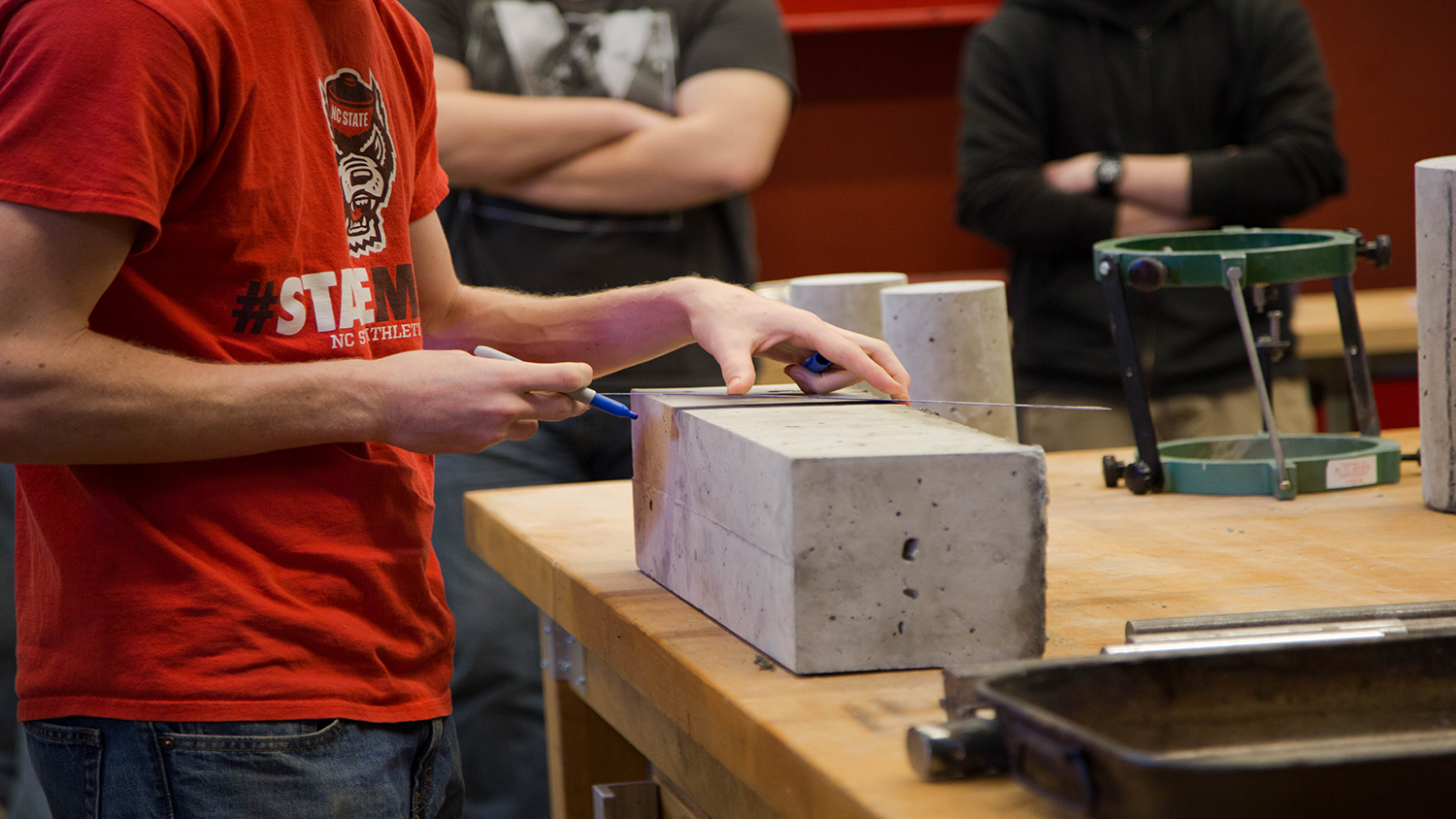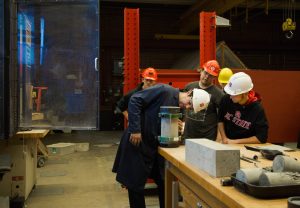A Work in Progress: Course Redesign for CE 332

DELTA staff members are constantly working on new ways to enhance courses and increase student success. The work in progress feature will highlight the various innovative projects taking place at DELTA. In the Civil Engineering Materials of Construction (CE 332) course, a team of DELTA staff members are working with Dr. Cassie Castorena and Dr. Rudi Seracino on a Critical Path Course Redesign Grant. Since CE 332 is required for students in the major to complete, it is vital for DELTA staff to create an organized, accessible and engaging course.
What are the Instructional Challenges and Solutions?
According to project lead and Instructional Designer Jakia Salam, the course faced many instructional challenges that limited student success including a small lab space, limited teaching assistant (TA) resources and a need to use instructional design principles to reorganize the Moodle course site. Considering all of these factors, the DELTA team wants to better engage students by flipping the classroom and bringing videos of lab online, interactive quizzes and creating a consistent instruction manual for the TAs.
 Additionally, there was not a way to test student engagement during the labs. CE 332 experienced high drop, fail and withdrawal rates, which DELTA staff members hope to decrease by redesigning the course.
Additionally, there was not a way to test student engagement during the labs. CE 332 experienced high drop, fail and withdrawal rates, which DELTA staff members hope to decrease by redesigning the course.
In the small lab space, students were not able to get the full experience of the lab because they could not see the instruction. To combat this issue, Salam and her team are creating demonstration and lecture videos to be embedded into Moodle for students to watch prior to attending the lab or lecture. The goal of the flipped classroom approach for some of the labs is for students to watch the videos before they get to lab so they know what to expect and are more prepared.
The videos will also be equipped with an activity to evaluate student engagement. Currently, Castorena and Seracino are reviewing several options to deploy interactive quizzes to check engagement of the videos. A goal of the DELTA team is to create sustainable solutions and use technology faculty members are comfortable with so they can continue to benefit from the course redesign in the future.
For the TAs, DELTA staff members are working to create a TA resource manual to ensure consistency among the TAs and to improve their knowledge base which will then improve student’s understanding in labs. The team is considering ways to present the manual to the TAs.
“We are investigating animations and visuals to make it interesting,” Salam said. Along with visuals, the Moodle site is being reorganized into modules, where each lab video will be displayed in a corresponding section, to make it easier for students to navigate. An orientation video will also be included on the Moodle site for students to get to know their instructors and the course before it begins.
Since CE 332 is a critical path course, planning evaluations early in the course may increase engagement. “We will evaluate the student perception of the videos and if their learning improves from the videos,” said Salam. The DELTA team will also be adding evaluations to determine if there is an improvement in the written quality of lab reports.
What’s Going on Now?
According to Production Support Technician Todd Buker, the DELTA team is considering a relatively new process for the production of the course videos. “We are working with Lightboard which allows on-camera speakers to appear to write on the screen itself,” he said. Lightboard also makes use of PowerPoint presentations by letting the speaker display graphics directly on the screen.
“The purpose of these videos is to get basic information across to the classes without taking up class time,” Buker said. The DELTA team decided it would be best to have the instructor on screen with the material, but wanted something different than the Mediasite two-screen display.
“Rather than have the instructor side by side with their content, Lightboard allows the instructor to more directly interact with the content,” Buker said. These videos will also incorporate PlayPosit, an interactive quiz built into the video to check student engagement before moving on to the next unit.
What’s Next?
The Lightboard testing is complete, and the next step will be to shoot the videos. Buker said, “Our professor is editing her PowerPoint slides to make the best use of Lightboard.”
Salam is working to make sure the Moodle course is sustainable and easy for the faculty to use after the grant project is complete. The TA resource will also be created in the next steps of the project.
What’s Special about this Project?
According to Salam, bringing the lab experience online is interesting. Students will be able to learn about the lab and take the quiz before they even go to the lab in person. The flipped classroom will ensure each student is able to see and experience the lab in its entirety. The new lab videos will allow students to watch them as many times as they would like instead of being constrained by space and time in the in-person lab.
 Buker explained he is most interested in seeing what types of reactions the videos will get. “We are taking what used to be a 75-minute in-class lecture, breaking it into 10-15 minute units, allowing the professor to write and solve problems right on the screen, and then quizzing the students to make sure they got it,” he said. The students will be able to watch the videos on their own time, so Buker is interested to hear what they think of the new videos.
Buker explained he is most interested in seeing what types of reactions the videos will get. “We are taking what used to be a 75-minute in-class lecture, breaking it into 10-15 minute units, allowing the professor to write and solve problems right on the screen, and then quizzing the students to make sure they got it,” he said. The students will be able to watch the videos on their own time, so Buker is interested to hear what they think of the new videos.
In addition, the course redesign plan may be able to be used as a template for other courses in the future.
Salam explained the CE 332 course redesign is a great example of how DELTA and faculty work together to create the best courses possible. “The faculty members are already knowledgeable about how to write scripts and very open to new ideas,” she said. Salam added the faculty love what DELTA does for them.


